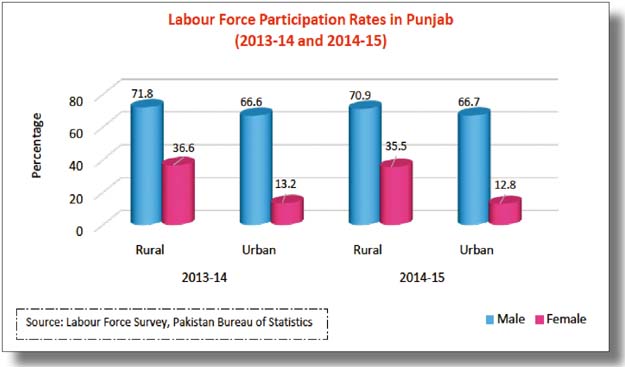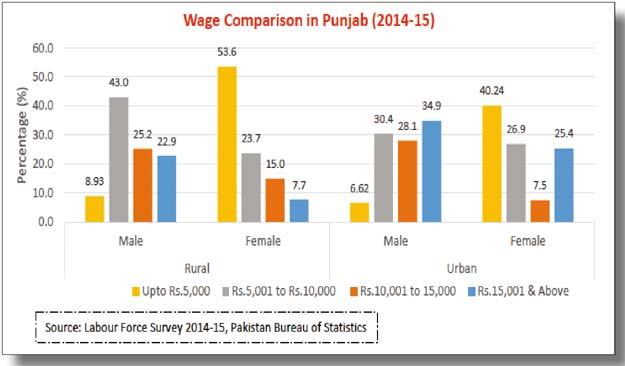
These figures were made public in the recently released Punjab Gender Disparity Report by the Punjab Commission on the Status of Women.
Data revealed that women’s participation in economic activities of Punjab had remained low since 2014-15. The Female Labour Force Participation Rate was only 27.8% as compared to 69.4% for males.
The share of female proprietors in both small-scale industries and cottage industries stood at 4.2% and 2.59%, respectively, which was significantly low.
According to the report that took its data from a Pakistan Bureau of Statistics survey in 2014-15, women formed almost 38% of the unemployed people in rural areas and 32.5% in urban centres.

Govt created 25,000 jobs for women
The gender parity index for unemployment was higher for rural areas at 0.607, compared to 0.483 for urban ones.
Further data revealed that significant disparities existed between male and female wages across major industries of Punjab. Almost 75% of the female labour force earned below the minimum wage of Rs14,000 compared to 43% of the male labour force.
Similarly, 50% of the female labour force and 7% of the male labour force fell below the lower wage bracket of Rs5,000 per month.
The high numbers of women, 50.9%, involved in piece rate work led to increased vulnerability of the female labour force. That was due to the uncertainty associated with the piece rate remuneration system.
The category of the ownership patterns of land, vehicle and financial instruments also revealed significant disparities across Punjab. As per the data, there were 49.8 million agricultural landowners in the province, out of which 34.9 million (70%) were men and just 14.9 million (30%) were women.

Punjab board, Women Chamber look to empower female farmers
Similarly, huge disparities were noted between the number of men and women who owned vehicles in Punjab. Out of 1,492,114 vehicles, 1,469,906 (98.5%) were owned by men and only 22,208 (1.5%) were owned by women. The GPI of vehicle ownership was very low at 0.015. Female owned loan accounts in the Bank of Punjab constituted only 9% of the total loan accounts in 2015-16, with a GPI of 0.098.
According to the report, under vision 2025, the government had committed to increasing the female Labour Force Participation Rate (LFPR) to 45%. Achieving this goal, however, would require both the federal and provincial governments to take immediate and definitive measures to increase the current female LFPR, which was an alarming 22% as compared to the male LFPR of 67.8%.
From 2003-4 to 2014-15, the female LFPR in Pakistan had witnessed a slight increase from 19% to 22%,. However, according to the Global Gender Gap Report 2016, Pakistan’s performance in reducing the gender gap had worsened over the past few years. Out of 144 countries, Pakistan’s economy was ranked at 143 in 2016 with a score of 0.33, as compared to 2006 when it was ranked at 112 with a score of 0.37.
According to the report, the low female labour force participation rate was a result of significant social and economic barriers faced by females.
The report stated that women’s role in society was generally limited to household activities, childbearing and upbringing. It added this hindered their participation in the formal labour force.
Investing in the human (or individual) potential of women, who constituted more than half of the world’s population, was the key to achieving economic growth as well as greater financial and social returns. Empowering women also resulted in reducing fertility rates; lower infant and child mortality rates, while ensuring greater participation in socioeconomic decision-making.
Published in The Express Tribune, October 19th, 2017.


















COMMENTS
Comments are moderated and generally will be posted if they are on-topic and not abusive.
For more information, please see our Comments FAQ